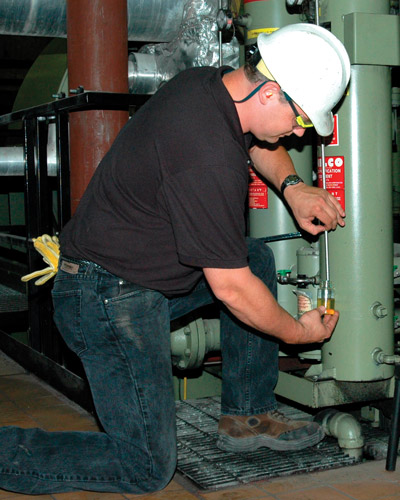Lube-Tips
The “Lube-Tips” section of Machinery Lubrication magazine features innovative ideas submitted by our readers. Additional tips can be found in our Lube-Tips email newsletter. If you have a tip to share, email it to editor@noria.com.
Reducing Hydraulic Failures
In hydraulic reservoirs, baffles are used to prevent fluid just returned to the tank from passing directly back to the pump inlet. For a number of reasons, a longer transit path is considered beneficial. It encourages better heat conduction from the fluid, better contamination control and air separation, and better mixing with the bulk fluid. This is usually accomplished by separating the inlet and outlet by as long of a flow path as feasible.
 Oil Sampling Caution
Oil Sampling Caution
When possible, don’t take oil samples from cold systems. Samples that are consistently collected from cold systems will have altered concentrations of wear metals, contaminants and other insoluble suspensions. When at rest, anything heavier than the oil will begin to settle. It takes only two minutes for a 20-micron particle of Babbitt bearing metal to settle 1/2 inch in an ISO 22 bearing oil. If unavoidable, cold systems should be labeled as such.
Lubricant Selection Advice
It is generally a good idea to avoid using extreme-pressure (EP) additives unless they are specifically required to reduce adhesive wear conditions (scuffing, galling, scoring, etc.). Some EP additives can decrease a lubricant’s oxidation stability (shortening service life). They can also be slightly corrosive to certain metals (e.g., yellow metals), especially at elevated temperatures.
 Keeping Grease Out of Motor Windings
Keeping Grease Out of Motor Windings
Before greasing motor bearings, install a pressure-sensitive (20-psi differential) grease-fill fitting that will not allow the cavity to be pressurized beyond 20 psi. This will minimize excessive pressure on the bearing shield and seal. Also, install a grease relief valve fitting to take the place of the grease drain plug. The grease relief valve will open between 1 and 5 psi and will minimize the overpressurization of the grease cavity. This also saves time in removing and reinstalling the grease drain plug.
Protect Bearings from Corrosion
In a humid environment, condensate can form in rolling-element bearings and cause corrosion, leading to a reduction of bearing life. The condensed moisture’s effect can be reduced by carefully choosing a grease lubricant. Greases thickened with sodium soap will absorb (emulsify) large quantities of water but may soften it to such an extent that the grease flows out of the bearing.
Although lithium soap greases do not emulsify water, with suitable additives they can provide good protection against corrosion. There are also a number of greases available containing synthetic thickeners, which offer excellent protection against corrosion to prolong bearing life.
Calculate and Display Lube Metrics
An industrial manufacturing plant found a way to show the effectiveness of its lubrication program to non-maintenance people in the facility. All of the three-part ISO particle count numbers were totaled and divided by the number of equipment pieces that were routinely sampled. This provided a plant-wide average oil cleanliness.
While this number means nothing by itself, every quarter it is recalculated using the latest sample results. This is used to show how the plant’s oil has become cleaner as the facility has begun to routinely filter oil and taken other actions to reduce contamination. Everyone can now see that the lube program is having a positive effect.
Bearing Vibration Activates Grease Failure
Excessive bearing vibration can have the same effect as irregular regreasing of bearing contact surfaces. It typically causes the grease to be broken down into the oil and the thickener. That is, the oil separates from the thickener.
Schedule Top-up Container Flushing
A maintenance facility discovered that it is best to put portable oil containers on a flushing schedule along with its equipment. Even though the plant only used new oil in these containers, over time debris would be found in each of them. The facility filtered new oil straight from the barrel, but somehow debris particles would still show up in the top-up containers.
The plant implemented a top-up container flushing schedule to keep contamination control at an optimum level. Once every four months, all portable containers are cleaned and flushed to ensure the debris does not reach the plant equipment. This drastically improved the cleanliness of the oils put in the equipment.
